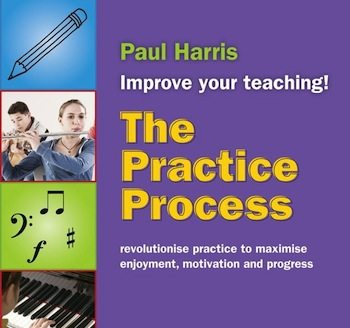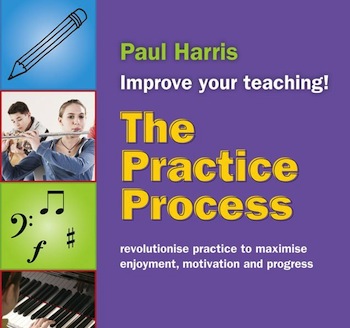 Paul Harris is one of the leading voices in music education in the UK and his forward-thinking publications have influenced music teachers around the world. Today sees the release of his latest book on the topic of instrument tuition: The Practice Process.
Paul Harris is one of the leading voices in music education in the UK and his forward-thinking publications have influenced music teachers around the world. Today sees the release of his latest book on the topic of instrument tuition: The Practice Process.
He kindly agreed to join us here on the site to answer some questions about this new book and his innovative “Simultaneous Learning” approach to teaching music.
It is clear that this is an educator fascinated by every aspect of teaching music—as the nearly 600 publications to his name attest—but it was his 2012 book The Virtuoso Teacher which most captured my attention. I had the good fortune of attending a workshop on the subject at a conference in late 2011, and Paul’s refreshingly enthusiastic and inclusive attitude to teaching music and his belief in the potential to improve on the status quo truly inspired me.
The “virtuoso” teacher advocated in the book is perhaps most characterised by mindfulness, with great care taken to ensure lessons aren’t prone to thoughtless repetition or reliance on routine. Instead, the passion for music shared by teacher and student is kept central, and lessons spent not dictating to the student and reacting to their attempts, but instead acting as facilitator to help the student learn, supporting them in a highly personal and engaged way.
The Virtuoso Teacher also touches on some key points about post-lesson practice. One core message is that practice must be made desirable, so that the student appreciates the purpose of practice and feels engaged with practising, rather than seeing it as a dull duty. This is tied in with the overall approach, called “Simultaneous Learning”, in which the student advances their knowledge through exploring each facet of their pieces (for example key, rhythm, dynamics, etc.) rather than simply working away at robotic reproduction of the notes on the page.
In his new book, The Practice Process, Paul dives more deeply into this question of how to design students’ practice to be most beneficial to them and help maintain their enthusiasm for music.
Let’s start with the biggie: what’s wrong with the traditional approach to practicing an instrument?
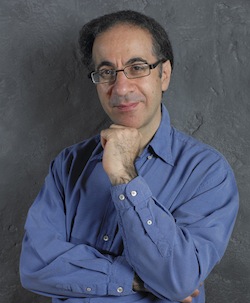 The problem is that teachers don’t make sufficient connections between the lesson and the practice. So often pupils go home not quite understanding what it is they are to do. Lessons and practice then become two discrete places which don’t connect. As a result pupils feel uncertain and uneasy.
The problem is that teachers don’t make sufficient connections between the lesson and the practice. So often pupils go home not quite understanding what it is they are to do. Lessons and practice then become two discrete places which don’t connect. As a result pupils feel uncertain and uneasy.
The challenge is to make practice a natural extension of the lesson, so it becomes the obvious thing to do as part of the ongoing process that is learning an instrument or singing.
There are two sides to this question. The first is the development of internalisation as part of practice. If we teach in the Simultaneous Learning way, then pupils are always hearing notated music in their head before they play or sing it. This requires a fair amount of careful preparation – but all pupils can do it if they know how.
The second side to this question is intelligent listening to others. We should always encourage pupils to listen to performances – online for example. And we should be very precise in what they are to listen to (we can’t expect them to give up more than a few minutes!).
Perhaps they listen to a passage to hear the result of a particular technique they are working at or the way some passage they are learning is phrased. Perhaps they listen to the use of tone and tone colour; or occasionally listen to a whole performance to get an understanding of structure or some aspect of performance technique.
They must be integrated – and that is what my Simultaneous Learning method of teaching is all about!
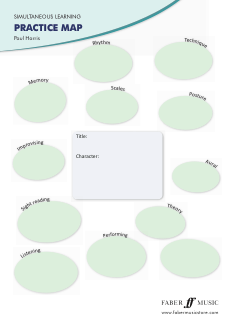
The well-worn ‘practice list’ of things to do is really not very efficient. Most pupils I have spoken to virtually ignore it completely!
The Simultaneous Learning Practice Map (available from Faber Music) is a very new idea. Instead of a list it’s a map of the various ingredients pupil and teacher are working on. Pupils can see, pictorially, what the ingredients are (of a particular piece or song) and how those ingredients join together to make the whole: the key, rhythms, markings, character alongside aural, theory, memory and other key aspects. They understand better why they are working on particular ingredients and they develop effective, meaningful and musical strategies for moving from one area to another.
The main message is two-fold:
- Firstly that teachers have to take much more responsibility for their pupils’ practice.
- Secondly is that practice has to be fun – and I don’t mean that in a frivolous sort of way. It has to be desirable, it has to be meaningful, it has to be something WE want to do. It’s not something we do because someone else wants us to do it.
Practise with your brain turned on.
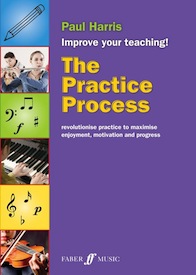 Whether you’re a music teacher or a student yourself, no doubt this interview has whet your appetite for information about Paul Harris’ approach to studying music more effectively!
Whether you’re a music teacher or a student yourself, no doubt this interview has whet your appetite for information about Paul Harris’ approach to studying music more effectively!
You can learn more on his website paulharristeaching.co.uk and his new book, The Practice Process, is available now from Faber Music and all leading retailers of music books.

